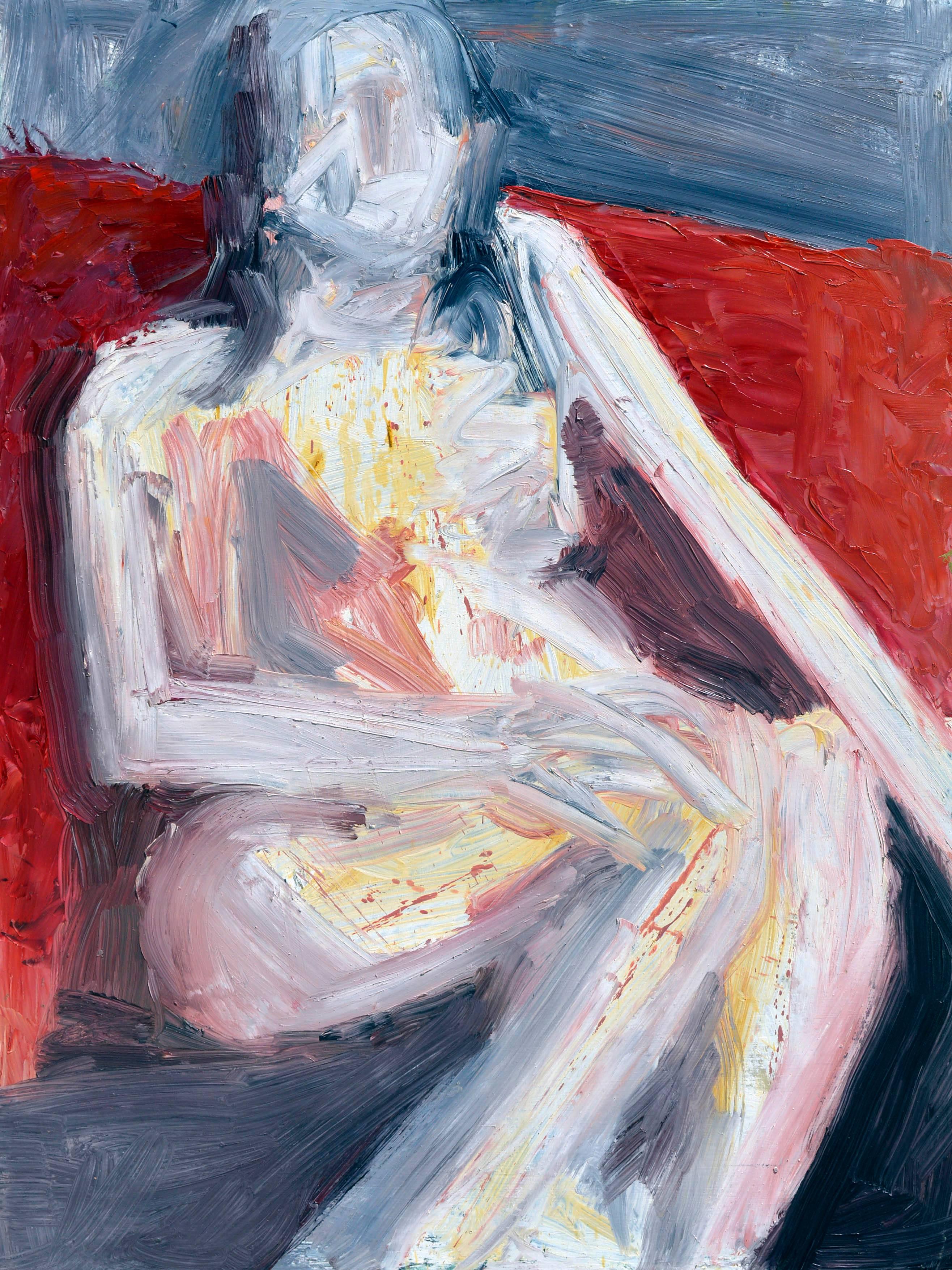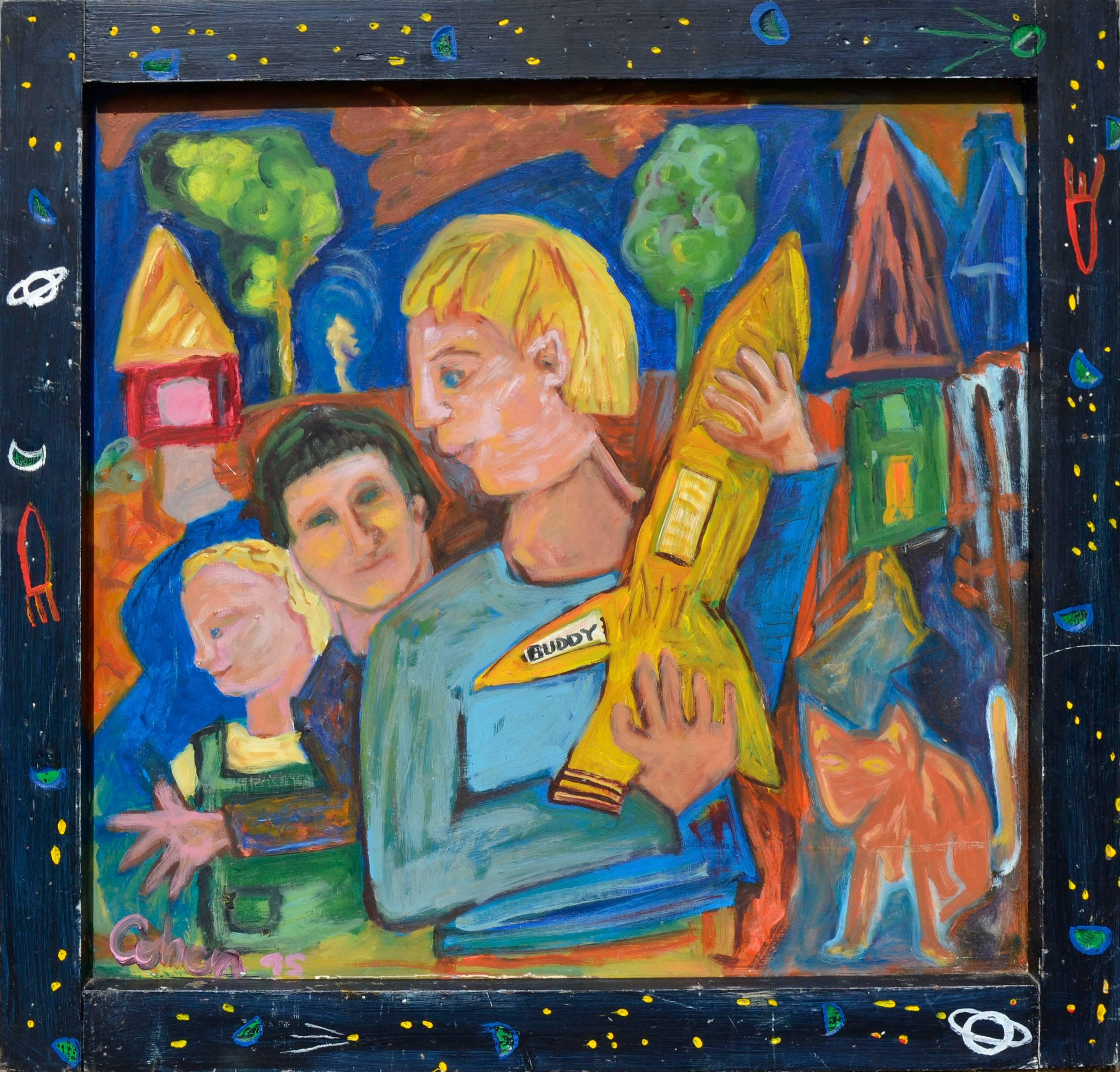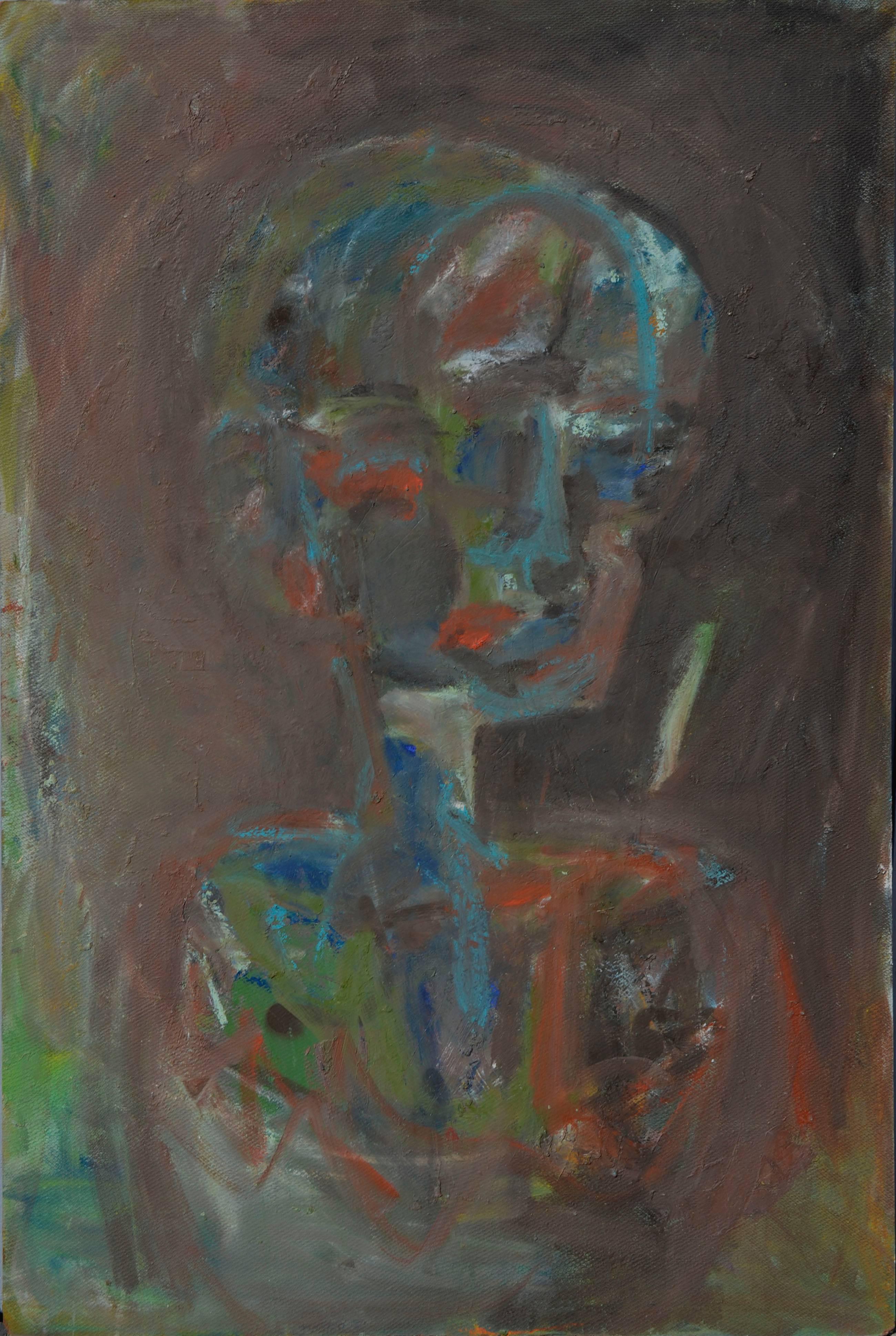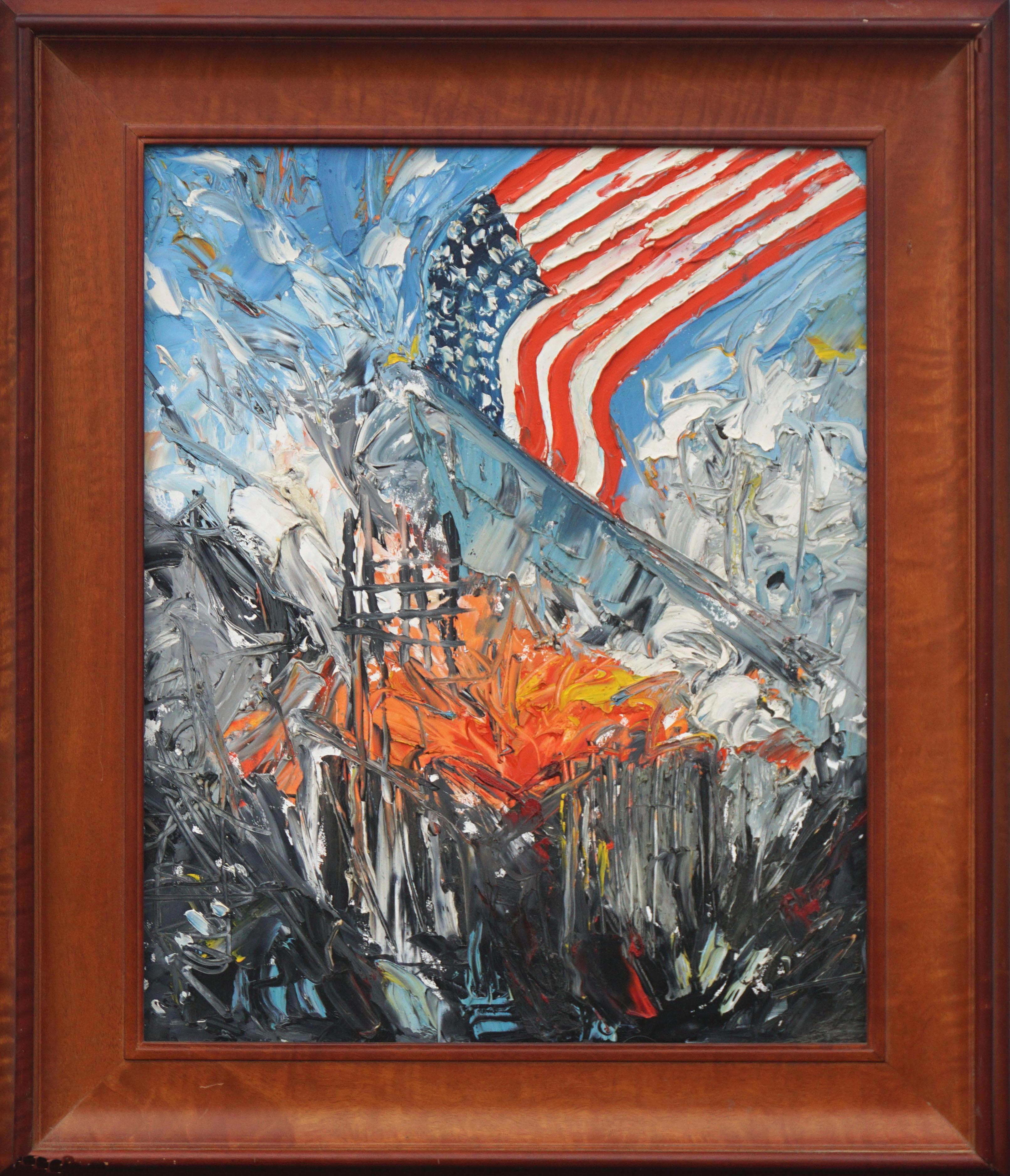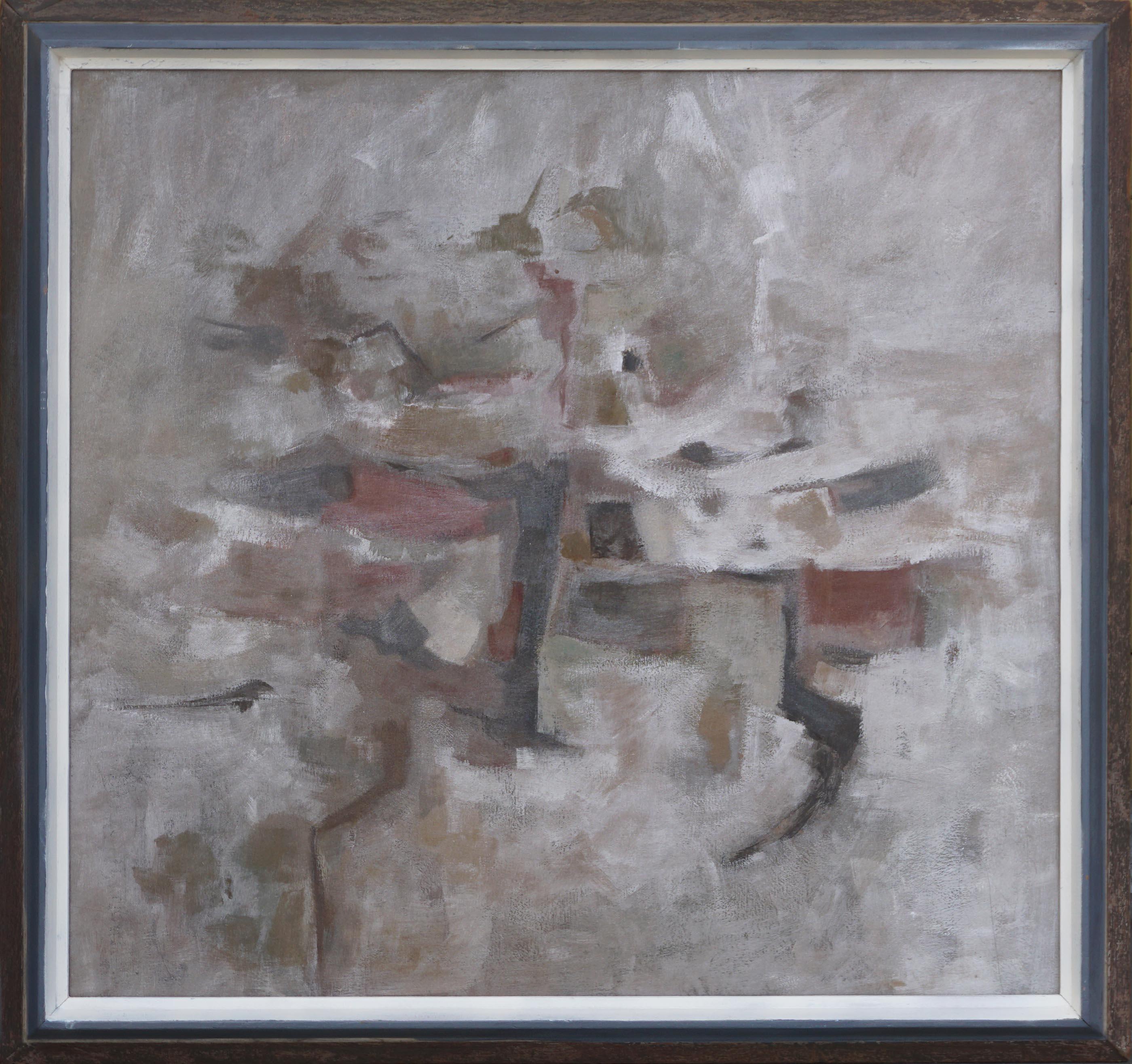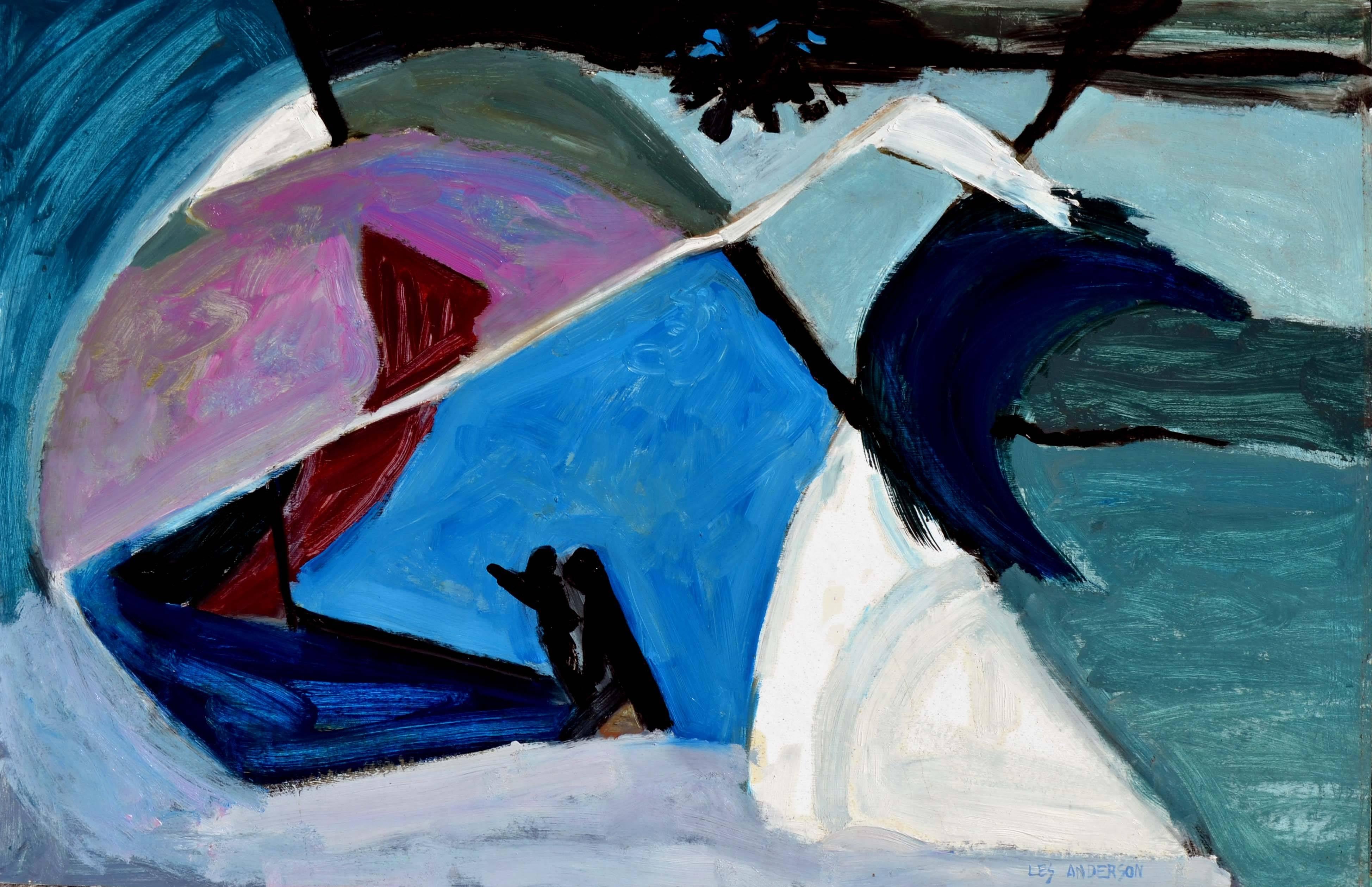Ben WilsonOzymandias (unique, signed Abstract Expressionist painting by renowned painter)1989
1989
About the Item
- Creator:Ben Wilson (1913-2001, American)
- Creation Year:1989
- Dimensions:Height: 36 in (91.44 cm)Width: 48 in (121.92 cm)Depth: 0.3 in (7.62 mm)
- Medium:
- Movement & Style:
- Period:
- Condition:Excellent original studio condition; there may be some minor fraying or paint loss around the far edges which will frame out.
- Gallery Location:New York, NY
- Reference Number:1stDibs: LU1745213023972
Ben Wilson
Born in Philadelphia, Ben Wilson was a New York Abstract Expressionist painter. His work was exhibited frequently from the mid-1930s through the 1960s, and less frequently but consistently through the rest of the century. Decade by decade beginning in the 1930s his painting comprises a micro history of the period’s art, while depicting what was foremost in the American consciousness of the time.
Wilson’s earliest work shows an intense awareness of social and economic turmoil of the 1930s. Dominating the content was the flow of world events beginning with the Spanish Civil War and followed by the rise of fascism, the Second World War and the plight of the persecuted, displaced and slaughtered minorities. Wilson was concerned with representing humanity and suffering in a changed world.
By the late 1950s Wilson began using abstraction in his paintings, merging himself with the “New York School” of art. He shared many of the values of Abstract Expressionists like Mark Rothko, Robert Rauschenberg, and Jasper Johns.
Through the 1960s, Wilson completed his transition to abstraction, exhibited in New York and Paris and received a Ford Foundation artist-in-residence grant. As the decade progressed he became increasingly experimental with his mediums, using house paint, sand and other unorthodox materials.
Ever one to pursue a personal aesthetic path regardless of popular movements and critical reactions, Wilson increasingly withdrew from the New York art scene from the 1970s on.
Throughout his life Wilson painted and drew every day. He left behind a large body of work and an extensive archive, including exhibition catalogues, reviews, and correspondence that are now part of the permanent collection of the George Segal Gallery at Montclair State University. A portion of his archives is in the Smithsonian Archives of American Art.
Wilson is listed in Who’s Who in Art; Who’s Who in the East; Dictionary of International Biography; American Artists of Renown and International Encyclopedia of Artists. His work is in numerous public collections, including the Hebrew Union College-Jewish Institute of Religion Museum, New York, NY; Jane Voorhees Zimmerli Museum, New Brunswick, NJ; Rutgers University Art Library and Classics Department, New Brunswick, NJ; Bryn Mawr College, Bryn Mawr, PA; Norfolk Museum, Norfolk, VA; and Fairleigh Dickinson University Collection of Self-Portraits, NJ.
Find original Ben Wilson paintings and other art on 1stDibs.
(Biography provided by Quogue Gallery)
- ShippingRetrieving quote...Ships From: New York, NY
- Return PolicyA return for this item may be initiated within 1 day of delivery.
- In the Sculpture Garden, unique signed oil on canvas painting, Charles CowlesLocated in New York, NYDonald McLaughlin In the Sculpture Garden (ex-collection Charles Cowles Gallery), 1985 Oil on Canvas. Framed with labels from Wolff Gallery and Charles Cowles Gallery Sticker label, ...Category
1980s Abstract Expressionist Abstract Paintings
MaterialsCanvas, Oil
- The City at Twilight: Twin Towers II, signed painting, Gruenebaum Gallery labelBy Sonia GechtoffLocated in New York, NYSonia Gechtoff The City at Twilight: Twin Towers II, 1985 Acrylic and pencil on paper (held in original frame with Gruenebaum Gallery, NY label) Signed and dated on the front; also b...Category
1980s Abstract Expressionist Abstract Paintings
MaterialsAcrylic, Pencil, Graphite
- Times Square III, New Years, unique painting by renowned contemporary artistBy Thelma AppelLocated in New York, NYThelma Appel Times Square III, New Years, 2014 Oil on canvas painting Hand signed, titled and dated on the back 41 × 31 × 1 1/2 inches Frame included This unique signed painting was ...Category
2010s Abstract Figurative Paintings
MaterialsOil, Acrylic
- ByzantiumBy Ben WilsonLocated in New York, NYBen Wilson Byzantium, 1975 Oil on Masonite painting Hand signed reverse, Titled, "Byzantium", dated 1975 by the artist and also with estate stamp - in addition to Ben Wilson's hand signature Frame included: elegantly framed in a handmade white wood frame with UV plexiglass This painting is done by the second generation Abstract Expressionist artist Ben Wilson - one of the youngest artists to be given a show at ACA Gallery in 1940. The work is signed by the artist on the back and also signed with the Estate Stamp and signature on the back. Ben Wilson was born in Philadelphia in 1913 to Jewish parents who had emigrated from Kiev and settled in New York City. He was educated in Manhattan public schools and graduated from City College in 1935. To gain exposure to a wider range of styles, he also studied at the National Academy of Design and at the Educational Alliance. Admired by critics throughout his long career, Wilson was singled out as a “discovery” by the New York Times art critic Edward Alden Jewel even before his first one-man show at the Galerie Neuf in 1946. His paintings of the ’30s and ’40s were expressionistically rendered, often Biblical parables, filled with what he called “the grief of the intolerable” and reflecting an acute awareness of the agony of the time, from the Holocaust to the Spanish Civil War. A WPA artist who identified strongly with the plight of the Jews in Europe, he relentlessly explored themes of war, torment, and futility in his early decades of painting. When times changed and social pressures subsided, Wilson’s mood lifted. He spent 1952-54 in Paris working at the Academie Julien. During the ’50s his involvement with specific imagery persisted but became more psychological and mythic in orientation. Influenced by Cubism, he created a vocabulary of interlocking shapes and bold, sweeping gestures that served as a transition between his early figurative expressionism and his later abstract constructivist concerns. Towards the end of the decade Wilson reached a crossroads, moving towards abstraction and searching for what he called “a scaffolding under the externals.” By 1960, influenced by the Russian Constructivists, Mondrian, and Abstract Expressionism, Wilson turned to abstraction. Reexamining the basic elements of painting, he evolved his own personal vocabulary and structure, fusing the cerebral and the emotive. He became increasingly experimental, using house paint, sand, and other unorthodox materials in paintings that he worked from all directions, dripping, spraying, stenciling, and collaging. He employed elements of disjunction, repetitions of geometric motifs, linear networks, and complex overlays to create the transparent, multi-layer development of space that characterizes his later paintings. A consummate draftsman, Wilson filled notebook after notebook with drawings that he amplified in his paintings. Eschewing popular movements, Wilson was always one to pursue a personal aesthetic. Despite more than 30 one-man shows and 50 years of teaching, he increasingly withdrew from the gallery scene but continued to paint daily until his death at age 88 in 2001 in Blairstown, New Jersey, where he and his sculptor wife Evelyn Wilson...Category
1970s Abstract Expressionist Abstract Paintings
MaterialsMasonite, Oil
- Concert (unique, signed Abstract Expressionist painting by celebrated artist)By Ben WilsonLocated in New York, NYBen Wilson Concert, ca. 1989 Oil on masonite board (Hand Signed by the artist; also bears the Estate Stamp) Boldly signed front and back, titled and dated on the back by Ben Wilson and also stamped on the back by the estate of Ben Wilson 42 × 48 inches Unframed This stunning painting is done by the second generation Abstract Expressionist artist Ben Wilson - one of the youngest artists to be given a show at prestigious ACA Gallery in 1940. This work "Concert" - depicting instruments, in a light, lyrically abstract painting. Exquisite colors and subtle imagery. In 2017, he was the subject of a retrospective at the George Segal Gallery at Montclair State University from September 6 to November 4 and it was accompanied by a catalogue. About Ben Wilson: Ben Wilson was born in Philadelphia in 1913 to Jewish parents who had emigrated from Kiev and settled in New York City. He was educated in Manhattan public schools and graduated from City College in 1935. To gain exposure to a wider range of styles, he also studied at the National Academy of Design and at the Educational Alliance. Admired by critics throughout his long career, Wilson was singled out as a “discovery” by the New York Times art critic Edward Alden Jewel even before his first one-man show at the Galerie Neuf in 1946. His paintings of the ’30s and ’40s were expressionistically rendered, often Biblical parables, filled with what he called “the grief of the intolerable” and reflecting an acute awareness of the agony of the time, from the Holocaust to the Spanish Civil War. A WPA artist who identified strongly with the plight of the Jews in Europe, he relentlessly explored themes of war, torment, and futility in his early decades of painting. When times changed and social pressures subsided, Wilson’s mood lifted. He spent 1952-54 in Paris working at the Academie Julien. During the ’50s his involvement with specific imagery persisted but became more psychological and mythic in orientation. Influenced by Cubism, he created a vocabulary of interlocking shapes and bold, sweeping gestures that served as a transition between his early figurative expressionism and his later abstract constructivist concerns. Towards the end of the decade Wilson reached a crossroads, moving towards abstraction and searching for what he called “a scaffolding under the externals.” By 1960, influenced by the Russian Constructivists, Mondrian, and Abstract Expressionism, Wilson turned to abstraction. Reexamining the basic elements of painting, he evolved his own personal vocabulary and structure, fusing the cerebral and the emotive. He became increasingly experimental, using house paint, sand, and other unorthodox materials in paintings that he worked from all directions, dripping, spraying, stenciling, and collaging. He employed elements of disjunction, repetitions of geometric motifs, linear networks, and complex overlays to create the transparent, multi-layer development of space that characterizes his later paintings. A consummate draftsman, Wilson filled notebook after notebook with drawings that he amplified in his paintings. Eschewing popular movements, Wilson was always one to pursue a personal aesthetic. Despite more than 30 one-man shows and 50 years of teaching, he increasingly withdrew from the gallery scene but continued to paint daily until his death at age 88 in 2001 in Blairstown, New Jersey, where he and his sculptor wife Evelyn Wilson...Category
1980s Abstract Expressionist Abstract Paintings
MaterialsMasonite, Oil
- Rock Candy Mountain (unique, signed Abstract Expressionist painting)By Ben WilsonLocated in New York, NYBen Wilson Rock Candy Mountain, ca. 1970 Oil on masonite board (Hand Signed, titled and dated) Hand signed, titled and dated by Ben Wilson on the back Frame Included: held in artist's original vintage 1970 wood frame This stunning painting with candy colors is done by the second generation Abstract Expressionist artist Ben Wilson - one of the youngest artists to be given a show at prestigious ACA Gallery in 1940. In 2017, he was the subject of a career retrospective at the George Segal Gallery at Montclair State University from September 6 to November 4 and it was accompanied by a catalogue. Measurements: Frame: 23.5 x 47.5 x 1 inch Artwork: 25 x 49 inches About Ben Wilson: Ben Wilson was born in Philadelphia in 1913 to Jewish parents who had emigrated from Kiev and settled in New York City. He was educated in Manhattan public schools and graduated from City College in 1935. To gain exposure to a wider range of styles, he also studied at the National Academy of Design and at the Educational Alliance. Admired by critics throughout his long career, Wilson was singled out as a “discovery” by the New York Times art critic Edward Alden Jewel even before his first one-man show at the Galerie Neuf in 1946. His paintings of the ’30s and ’40s were expressionistically rendered, often Biblical parables, filled with what he called “the grief of the intolerable” and reflecting an acute awareness of the agony of the time, from the Holocaust to the Spanish Civil War. A WPA artist who identified strongly with the plight of the Jews in Europe, he relentlessly explored themes of war, torment, and futility in his early decades of painting. When times changed and social pressures subsided, Wilson’s mood lifted. He spent 1952-54 in Paris working at the Academie Julien. During the ’50s his involvement with specific imagery persisted but became more psychological and mythic in orientation. Influenced by Cubism, he created a vocabulary of interlocking shapes and bold, sweeping gestures that served as a transition between his early figurative expressionism and his later abstract constructivist concerns. Towards the end of the decade Wilson reached a crossroads, moving towards abstraction and searching for what he called “a scaffolding under the externals.” By 1960, influenced by the Russian Constructivists, Mondrian, and Abstract Expressionism, Wilson turned to abstraction. Reexamining the basic elements of painting, he evolved his own personal vocabulary and structure, fusing the cerebral and the emotive. He became increasingly experimental, using house paint, sand, and other unorthodox materials in paintings that he worked from all directions, dripping, spraying, stenciling, and collaging. He employed elements of disjunction, repetitions of geometric motifs, linear networks, and complex overlays to create the transparent, multi-layer development of space that characterizes his later paintings. A consummate draftsman, Wilson filled notebook after notebook with drawings that he amplified in his paintings. Eschewing popular movements, Wilson was always one to pursue a personal aesthetic. Despite more than 30 one-man shows and 50 years of teaching, he increasingly withdrew from the gallery scene but continued to paint daily until his death at age 88 in 2001 in Blairstown, New Jersey, where he and his sculptor wife Evelyn Wilson...Category
1970s Abstract Expressionist Abstract Paintings
MaterialsPermanent Marker, Oil, Masonite
- Abstract Expressionism --Seated Woman FigurativeBy Daniel David FuentesLocated in Soquel, CAFigurative abstract painting by San Jose, California area artist Daniel David Fuentes (American, 20th Century). San Francisco bay area abstract expressionist and landscape artist dur...Category
21st Century and Contemporary Abstract Expressionist Figurative Paintings
MaterialsMasonite, Oil
- Rocket Boy Abstract Expressionist FigurativeBy Kristin CohenLocated in Soquel, CAA lighthearted figurative abstract by Bay Area artist Kristin Cohen (American, b.1963). Signed and dated lower left, "Cohen '95." Presented in the artist's painted wood frame. From ...Category
1990s Abstract Expressionist Figurative Paintings
MaterialsMasonite, Oil
- Looking Away - Figurative AbstractBy Daniel David FuentesLocated in Soquel, CAA figurative abstract painting on masonite by San Francisco, California area artist Daniel David Fuentes (American, 1978-2016). San Francisco Bay Area abstract expressionist and land...Category
1990s Abstract Expressionist Figurative Paintings
MaterialsMasonite, Oil
- America Rising - Patriotic 9/11 Figurative AbstractBy Jocelyn AudetteLocated in Soquel, CAVivid and evocative abstracted painting of 9/11 by artist Jocelyn Audette (American, b. 1952), circa 2001. Impasto adds texture and interest. Label on verso with artist's name. Pres...Category
Early 2000s Abstract Expressionist Abstract Paintings
MaterialsMasonite, Oil
- Mid Century Modern Silver & Earthtone Abstract Expressionist - Corban LepellLocated in Soquel, CAGorgeous mid century modernist abstract combining earth-tones and subtlest metallic silver background by Corban LePell (American, b. 1933), 1955. Signed ...Category
1950s Abstract Expressionist Abstract Paintings
MaterialsMasonite, Oil
- Mid Century Abstract Expressionist Painting-- "An Oblation to Shells"By Leslie Luverne AndersonLocated in Soquel, CAA dymanic mid century abstract expressionist painiting with geometric shapes in cool tones and two figures by Leslie Luverne Anderson (American, 1928-2009). Oil on masonite. Titled "...Category
1960s Abstract Expressionist Abstract Paintings
MaterialsMasonite, Oil
